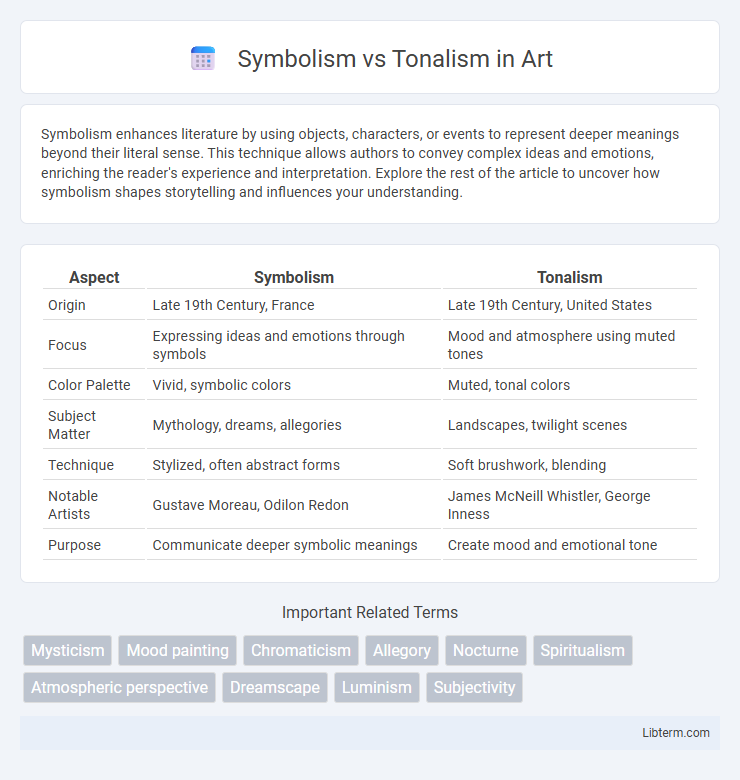Symbolism enhances literature by using objects, characters, or events to represent deeper meanings beyond their literal sense. This technique allows authors to convey complex ideas and emotions, enriching the reader's experience and interpretation. Explore the rest of the article to uncover how symbolism shapes storytelling and influences your understanding.
Table of Comparison
| Aspect | Symbolism | Tonalism |
|---|---|---|
| Origin | Late 19th Century, France | Late 19th Century, United States |
| Focus | Expressing ideas and emotions through symbols | Mood and atmosphere using muted tones |
| Color Palette | Vivid, symbolic colors | Muted, tonal colors |
| Subject Matter | Mythology, dreams, allegories | Landscapes, twilight scenes |
| Technique | Stylized, often abstract forms | Soft brushwork, blending |
| Notable Artists | Gustave Moreau, Odilon Redon | James McNeill Whistler, George Inness |
| Purpose | Communicate deeper symbolic meanings | Create mood and emotional tone |
Introduction to Symbolism and Tonalism
Symbolism emerged in the late 19th century as an art movement emphasizing the expression of ideas and emotions through symbolic imagery and metaphoric content. Tonalism, prevalent primarily in American landscape painting during the same period, concentrates on mood and atmosphere using muted tones and soft brushwork to evoke a sense of tranquility. Both movements diverged from realism by prioritizing subjective experience over objective depiction, influencing the evolution of modern art.
Historical Origins of Symbolism
Symbolism emerged in the late 19th century as a reaction against naturalism and realism, originating primarily in France and Belgium during the 1880s. Influenced by French poets such as Charles Baudelaire and Stephane Mallarme, Symbolist artists sought to express mystical ideas, emotions, and the intangible through symbolic imagery and metaphorical representation. This movement laid the groundwork for later modernist developments by emphasizing subjective experience and inner visions rather than direct depiction of the visible world.
The Emergence of Tonalism
Tonalism emerged in the late 19th century as a response to the vivid color and detailed representation of Symbolism, emphasizing mood and atmosphere through muted palettes and soft brushstrokes. Key figures like James McNeill Whistler and George Inness pioneered this style, capturing landscapes with subtle tonal variations to evoke emotional resonance. Tonalism's focus on harmony and the interplay of light and shadow marked a significant shift towards abstraction and atmospheric expression in American art.
Key Principles of Symbolism
Symbolism emphasizes the use of metaphorical imagery and symbolic figures to express ideas, emotions, and spiritual truths beyond literal representation. It prioritizes subjective experience, mysticism, and the exploration of dreams and the subconscious through ambiguous and evocative visuals. Key principles include an emphasis on imagination, the use of archetypal symbols, and a rejection of realism in favor of conveying deeper meanings.
Defining Features of Tonalism
Tonalism is characterized by its emphasis on muted color palettes, soft brushwork, and atmospheric effects that create mood and intimate scenes, distinguishing it from Symbolism's focus on mystical themes and allegory. Key defining features of Tonalism include the use of monochromatic or limited color schemes, subtle gradations of tone, and a preference for landscapes during twilight or foggy conditions to evoke tranquility and introspection. This movement prioritizes emotional resonance through visual tone over the symbolic content prevalent in Symbolism.
Notable Symbolist Artists and Works
Notable Symbolist artists such as Gustav Klimt, Odilon Redon, and Pierre Puvis de Chavannes emphasized mystical and dreamlike imagery to evoke emotions beyond the visible world, contrasting sharply with Tonalism's muted color palettes and atmospheric effects. Klimt's "The Kiss" exemplifies the Symbolist focus on erotic and allegorical themes, while Redon's works like "The Cyclops" delve into mythological and imaginative realms. Pierre Puvis de Chavannes' murals, including "The Sacred Grove," highlight the spiritual symbolism central to Symbolism, setting it apart from Tonalism's landscape-driven narratives.
Renowned Tonalist Painters and Masterpieces
Renowned Tonalist painters such as James McNeill Whistler, George Inness, and Albert Pinkham Ryder emphasized mood and atmosphere through muted palettes and soft brushwork to evoke emotional depth. Whistler's masterpiece, "Nocturne in Black and Gold," exemplifies the tonal approach with its subtle gradations of color and light, creating a dreamlike ambiance. Unlike Symbolism's use of mythological and allegorical imagery, Tonalism focuses on the natural landscape rendered in delicate tones to capture transient effects of light and shadow.
Symbolism vs Tonalism: Style and Technique
Symbolism emphasizes vivid, often surreal imagery and allegorical content to evoke emotions and ideas, utilizing bold colors and detailed forms to convey spiritual or mystical themes. Tonalism focuses on subdued color palettes and soft, diffused light to create atmospheric landscapes characterized by mood and tranquility, often employing subtle gradations of tone and simplified compositions. While Symbolism relies on symbolic content and intricate detail, Tonalism prioritizes tonal harmony and the evocation of mood through muted, harmonious color schemes.
Thematic Contrasts between Symbolism and Tonalism
Symbolism emphasizes mystical, dream-like themes with an exploration of spirituality, emotions, and the subconscious mind, often using vivid symbols to convey abstract ideas. Tonalism focuses on mood and atmosphere through muted color palettes and subtle gradations, highlighting themes of tranquility, nature, and introspective reflection. Thematic contrasts arise as Symbolism delves into symbolic and metaphysical narratives, while Tonalism prioritizes the sensory experience of natural landscapes and emotional nuance.
Legacy and Influence on Modern Art
Symbolism's legacy lies in its rich use of mythological and dream imagery, deeply influencing modern art movements like Surrealism and Expressionism through its focus on emotional and mystical content. Tonalism's subtle manipulation of light and atmosphere paved the way for American Impressionism and contemporary landscape painting, emphasizing mood over detailed representation. Both movements challenged traditional realism, contributing to the evolution of modern artistic expression by prioritizing subjective experience and emotional depth.
Symbolism Infographic

 libterm.com
libterm.com